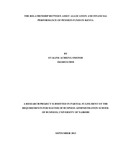| dc.description.abstract | The relationship between asset allocation and financial performance of pension funds is critical in determining whether asset allocations as selected by Trustees of pension
schemes is critical in increasing pensioners’ wealth in Kenya. Given that the primary
reason for the establishment of pension schemes is to alleviate old age poverty for their
members, it is paramount that the pension funds be invested in manner that is consistent
with the spirit of increased performance of the fund. Where is this not done proactively
then, as might be expected, value of the pension funds will decrease, leaving its members worse off than if they had benefited from their contributions now rather than in the future.
However, as the regulator, RBA is concerned with whether trustees have developed an
Investment Policy (IP) and adhere to it. There is therefore a gap when it comes to
evaluating the effectiveness of those IPs in increasing wealth.
The study adopted a descriptive survey and utilized a sample of 245 schemes that drawn from a population of 1214 schemes in Kenya. The sample included only those schemes that invested in segregated funds, were in existence for at least 7 years, have consistently used fund manager over the period of the study and had a fund value of at least Ksh. 100 Million as at the end of 2011 was used and the data analyzed. The secondary data on pension schemes asset allocation and returns was obtained from Retirement Benefits Authority was analyzed using descriptive statistics. The quantitative obtained data was analyzed in two stages. First, the R-Square (Coefficient of Determination) was calculated in order to explain how much of the variability of fund returns can be caused or explained by asset allocation. The purpose of this stage was to corroborate the findings by Nguthu (2009), who in his study showed that asset allocations only explained 37% of pension fund performance in Kenya. The second stage of the analysis was to determine the relative importance of each asset class to the overall financial performance of the fund. A paired sample T-Test was used for this analysis.
The findings of the study were that asset allocation explains 28% of the variability of
fund returns. The remaining 72% is explained by other factors such as asset class timing, security selections and manager selection. Further the study established that of all the asset classes permitted by the Retirement Benefits Authority (RBA), investments in equities was relatively more important than investments in fixed deposits in determining
the overall performance of the pension funds.
The study recommends that the retirement benefits schemes should be less regulated by relaxing the rule for strict adherence to the investment policies. In addition, RBA should revise the policy and allow fund managers should to fully exercise active management of the funds without strictly adhering to the investment guidelines provided by RBA, but only use them as a guide. This is because the asset allocation in Kenya account for only 28% of the fund performance. If this is achieved, fund managers should focus more attention on investments in equities as opposed to fixed deposits. This is supported by the second stage of the analysis which found that investment in cash was relatively more important than investment in fixed deposits in the determination of the overall performance of the pension funds. | en |

